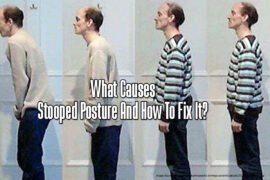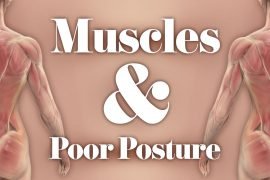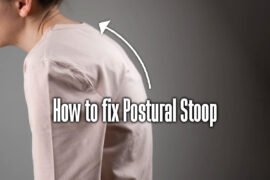[Updated on 1 May 2023] Upper Crossed Syndrome (UCS) is a condition that affects the muscles and joints of the upper body, specifically the neck, shoulders, and upper back. It is caused by a combination of muscular imbalances and poor posture, often due to long hours spent sitting and staring at screens. UCS can lead to various unpleasant symptoms, including chronic pain, headaches, and decreased range of motion.
Fortunately, there are several effective methods for fixing Upper Crossed Syndrome. These may include targeted exercises to strengthen weak muscles, stretching to release tight ones, and lifestyle changes to improve posture and reduce screen time. With a little effort and dedication, it’s possible to alleviate the symptoms of UCS and restore balance to the upper body. In this article, we’ll explore the most effective exercises for fixing Upper Crossed Syndrome. We provide practical advice for anyone looking to correct their posture and reduce pain & discomfort in the upper body.
What Is Upper Crossed Syndrome?
Table of Contents
Upper Crossed Syndrome (UCS) refers to an imbalance in your shoulders, neck, and chest muscles where few are too weak, and few are too tight. The muscles in the upper body appear to form the shape of an X in the side view, which is why the condition is named as such. If your shoulder, neck, and chest muscles are not properly coordinated, it can cause noticeable and painful effects.
Meanings Of ‘Crossed’ And ‘Countercrossed’
The term “crossed” in upper crossed syndrome describes the pattern in which the overactive muscles cross with the underactive muscles in a counter-crossing pattern. These two sets of muscles form an X pattern when viewed from the side. There is a diagonal pattern of overactive muscles that starts from the neck’s back with the upper trapezius and levators and goes down towards the neck’s front and shoulder with the sternocleidomastoid (SCM) and pectoralis major.
The other side of the X now shows the less active muscles, including the deep cervical flexors located near the mid/lower trapezius, rhomboids, and serratus anterior. The more we sit with a forward head posture due to electronic devices or improper exercise form, the more likely these muscle imbalances will develop in an X pattern.
Causes Of Upper Crossed Syndrome
The causes of Upper Crossed Syndrome can include:
- Prolonged sitting: Sitting for a long time can cause weakness in the upper back muscles while tightening the chest and hip flexor muscles.
- Poor posture: Poor posture, such as hunching over a computer and looking down at a phone for a long period of time, definitely contribute to muscle imbalances and joint dysfunction.
- Repetitive motions: Repetitive motions, like typing or using a mouse, can cause overuse injuries and muscle imbalances.
- Lack of exercise: Lack of exercise may contribute to muscle weakness and imbalances, particularly in the upper body.
- Stress: Chronic stress can lead to muscle tension and contribute to the development of UCS.
- ITrauma: Trauma or injury to the neck, shoulders, or upper back can cause muscle imbalances and joint dysfunction.
- Genetics: Some people can be more predisposed to developing UCS due to genetic factors.
Symptoms Of Upper Crossed Syndrome
The following are some common symptoms of Upper Crossed Syndrome:
- Forward head posture: This is when a head juts forward in front of the shoulders, causing strain on the neck and upper back.
- Rounded shoulders: Rounded shoulders are when the shoulders roll forward and the chest caves in, causing a hunched-over posture.
- Neck pain: Pain and neck stiffness can result from the forward head posture.
- Shoulder pain: Pain in the shoulders can result from the rounded shoulder posture and the associated strain on the shoulder muscles.
- Headaches: Chronic tension headaches can occur due to neck strain and upper back muscles.
- Limited range of motion: The postural imbalances associated with UCS can limit the range of motion in the neck, shoulders, and upper back.
- Muscle tightness: Tightness in the chest, neck, and shoulder muscles can result from the chronic strain of UCS.
How Is Upper Crossed Syndrome Diagnosed?
If you are experiencing UCS, you might feel stressed in your shoulders and neck. Have you noticed if the situation has been worse over time? You usually experience stress when engaging in activities that initially cause the imbalance.
You could be experiencing one or multiple symptoms from the following list:
- Lower back pain
- Tight or painful neck muscles
- Soreness around the shoulder blades
- Difficulty driving due to muscle tightness or pain
- Frequent shifting while sitting, using a computer, or watching TV
If you’re experiencing these symptoms, it’s essential to inform your doctor. During your medical examination, your doctor will focus on your head’s forward angle, which may look like hunching due to Upper Cross Syndrome (UCS). The doctor will examine the position and movement of your neck and shoulders.
If you are exhibiting any of these typical external symptoms of UCS, your doctor will likely be able to detect it.
- Protruding shoulder blades.
- An inward curving spine at the neck.
- Head or neck slouched forward.
- Rounded forward Shoulders.
If you are experiencing frequent headaches, specifically tension headaches, it is important to inform your doctor. UCS has been identified as a potential trigger for headaches.
Treatment Options To Fix Upper Crossed Syndrome
The treatment options for UCS include the following:
- Posture correction: Poor posture is one of the main causes of UCS. Correcting posture can help to alleviate pain and prevent further damage to the joints and muscles. This can be achieved through ergonomic adjustments, such as adjusting your computer screen height, chair, and keyboard.
- Manual therapy: Manual therapy, like massage or chiropractic manipulation, can help to release tension and improve the alignment of the spine and joints. This can reduce pain & improve the range of motion.
- Electrical stimulation therapy: Electrical stimulation therapy uses low-level electrical currents to stimulate muscles and nerves in the affected areas. This can help to alleviate pain, improve circulation, and promote healing.
- Medications: Over-the-counter pain medications, like acetaminophen or ibuprofen, may be used to reduce inflammation and alleviate pain. In some cases, muscle relaxants or prescription pain medications may be necessary.
- Surgery: In severe cases of UCS, surgery may be necessary to correct the muscle imbalance and alleviate pain. However, this is typically considered a last resort and is only recommended when other treatments have failed.
Best Exercises To Fix Upper Crossed Syndrome
The best way to fix UCS is through a combination of strengthening and stretching exercises. Here are some exercises that can help fix Upper Crossed Syndrome:
Chin Tuck
Chin tucks is one of the best exercises for correcting forward head posture, a common component of UCS. This exercise strengthens the deep cervical flexors, which are often weak in individuals with UCS. To perform a chin tuck exercise, sit or stand with your back straight, then gently pull your chin back towards your neck without tilting your head down or back. Hold the position for some seconds, then relax and repeat.
Shoulder Blade Squeeze
Shoulder blade squeeze help strengthen the muscles between your shoulder blades, which are often weak in individuals with UCS. To perform this shoulder blade squeeze exercise, sit or stand with your back straight, then pull your shoulder blades back & down towards your spine. Although you’re trying to hold a pencil between them. Hold the squeeze for some seconds, then relax and repeat.
Chest Stretch
Chest stretches help to relieve tightness in the chest muscles, which are often tight in individuals with UCS. To perform the chest stretch, stand in a doorway with your arms out of your side, and elbows bent at 90 degrees. Step forward with one foot, then gently lean forward until you sense the stretch in your chest. Hold the chest stretch for 15 to 30 seconds, then relax and repeat.
Upper Trapezius Stretch
The upper trapezius muscle is often tight in individuals with UCS, and stretching this muscle may help relieve shoulder and neck tension. To perform this upper trapezius stretch, sit or stand with your back straight, then bring your left ear towards your left shoulder, gently pulling your head with your left hand. Hold the upper trapezius stretch for 15 to 30 seconds, then repeat this exercise on the other side.
Prone Cobra
The prone cobra exercise helps to strengthen the muscles of the lower neck, upper back, and shoulders, which are often weak in individuals with UCS. To perform the prone cobra exercise, lie face down on a mat with your arms, sides, and palms down. Lift your chest and arms off a mat, and squeeze your shoulder blades together. Hold the position for seconds, then relax and repeat.
Seated Row
Seated row is an excellent exercise for strengthening the upper back muscles, which are often weak in individuals with UCS. To perform this exercise, sit on a rowing machine or cable row machine with your feet flat on the ground and bent knees slightly. Start by holding the handles with your palms facing each other. Next, pull the handles towards your chest while squeezing your shoulder blades together. Hold the position for some seconds, then release and repeat.
Face Pulls
Face pulls help to strengthen the upper back muscles and shoulders, which are often weak in individuals with UCS. To perform this exercise, attach a rope or handle to a cable machine at your chest height. Stand facing a machine with feet shoulder-width apart & arms extended in front of you, then holding the handle or rope. Pull the rope or handle towards your face, squeezing your shoulder blades together. Hold the position for some seconds, then release and repeat.
Tips For Avoiding Upper Cross Syndrome In The Future
Make sure to avoid positions that cause discomfort or numbness, and practice sitting or standing in a comfortable position to improve your posture. Make sure you don’t turn slouching into a habit.
Some suggestions to improve your posture are listed below.:
- Take care of your weight.
- Make sure to wear shoes that provide proper support.
- To avoid straining your neck, elevate the book or screen to match your eye level instead of lowering your head.
- Adjust either your chair or desk’s height to achieve the correct posture.
- Remember to take breaks and stretch every so often if you are sitting for a long time.
- If you’ve to stand for long periods, it is good to rest one foot on a short and sturdy object for support.
- Use rolled towels or pillows to support your neck and lower back while in bed.
- Make sure to work out the neck, shoulders, and chest muscles at least two or three times a week.
- Make it a habit to exercise your core muscles, back, and abdomen every day. Even a short walk can help you achieve this.
FAQs
Q1. What is the best remedy for someone with upper cross syndrome?
Some of the most effective treatments are mobility, flexibility exercises, and spinal adjustments for treating the upper cross syndrome. Upper cross syndrome issues can be addressed through a combination of regular stretching, strengthening weak muscles, managing corrective posture, and making adjustments.
Q2. Is upper cross syndrome serious?
Upper Cross Syndrome is a condition that can cause persistent muscle imbalances in the body and result in chronic back pain. Regularly active individuals or athletes may experience decreased mobility and reduced overall performance as a result of developing a muscular imbalance.
Q3. Does massage help with upper cross syndrome?
Sports Massage can effectively reduce upper cross syndrome by targeting the affected muscles. Massage can help alleviate tightness in the Upper Trapezius, Levator Scapulae, and Pectoralis Major/Minor muscles by stretching and relaxing them to return to their natural condition.
Q4. What is the perfect sleeping position for upper crossed syndrome?
Sleeping on your side can often be the cause of neck pain and upper back, as well as headaches, which is something many people tend to overlook. Sleeping on your back is recommended for many people. Initially, it may be challenging, so try lying on your back for 20 minutes before going to bed.
Q5. Does yoga help with upper cross syndrome?
Yoga is an effective way to regain balance. One of the ways to address the posture problems caused by upper crossed syndrome is to lengthen the muscles located in the front of the chest. In yoga, this can be achieved by performing back-bending poses.
Q6. What muscles are weak in upper cross syndrome?
The upper-crossed syndrome occurs when one group of muscles becomes weak while the other group of muscles becomes tight. Weak deep-neck flexors and tight pectorals, and sternocleidomastoid muscles cause this syndrome.
Conclusion
In conclusion, Upper Crossed Syndrome is characterized by a combination of muscular imbalances, which may cause pain and discomfort in the shoulders, upper back, and neck.
Fortunately, Upper Crossed Syndrome can be prevented or corrected through regular exercise, including stretching and strengthening exercises targeted at the affected muscle groups. It’s essential to maintain good posture and take frequent breaks from sitting to avoid exacerbating the condition.
Overall, understanding the causes and symptoms of Upper Crossed Syndrome and taking proactive measures to address it can lead to improved comfort and mobility and a better quality of life.







